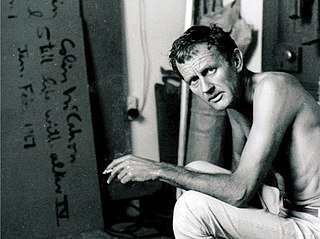
A general practitioner (GP) or family physician is a doctor who is a consultant in general practice.

Colin John McCahon was a New Zealand artist whose work over 45 years consisted of various styles, including landscape, figuration, abstraction, and the overlay of painted text. Along with Toss Woollaston and Rita Angus, McCahon is credited with introducing modernism to New Zealand in the mid-20th century. He is regarded as New Zealand's most important modern artist, particularly in his landscape work.

The University of Otago, Wellington is one of seven component schools that make up the University of Otago Division of Health Sciences. All University of Otago medical students who gain entry after a competitive Health Sciences First Year programme, or who gain graduate entry, spend their second and third years studying in Dunedin in a programme called Early Learning in Medicine (ELM), which is jointly taught by the Otago Medical School and the School of Biomedical Sciences. In their fourth, fifth, and sixth years, medical students study at one of three clinical schools: either Otago Medical School or the University of Otago, Christchurch or the University of Otago, Wellington.
Alice Mary Bush was a pioneering New Zealand female physician, paediatrician and activist for family planning services and abortion access.

St Patrick's College is a state-integrated Catholic boys' day and boarding secondary school located in Silverstream, Upper Hutt, New Zealand. It was established in 1931 when the original St Patrick's College, Wellington that had been established in 1885 was intended to be moved to a larger site more suited to a boarding school, but both colleges survived as independent institutions.

Sir Edward George Sayers was a New Zealand medical doctor, parasitologist, Methodist missionary, military medical administrator, consultant physician and, from 1958 to 1968, Dean of the University of Otago, School of Medicine. Having trained as a doctor, from 1927 to 1934 he worked at the Methodist mission in the Solomon Islands where he carried out fieldwork in the treatment of malaria. The significance of this work became apparent when Sayers used his knowledge to reduce deaths of American, Australia and New Zealand military forces during the invasion of Pacific Islands during World War II. He served as a doctor with the 2nd Division 2 NZEF during 1941–42 in Greece and North Africa. In 1942 he was transferred to the Pacific to serve with the 3rd Division, 2 NZEF IP.
Michael Herbert Watt was a New Zealand medical doctor and public health administrator.
Muriel Helen Deem was a New Zealand medical doctor, medical officer, Plunket medical adviser and university lecturer.
Thomas Vianney O'Donnell was a New Zealand medical practitioner and academic.
Sir Neil Colquhoun Begg was a New Zealand paediatrician, historian and cricketer. He played three first-class matches for the Otago cricket team after the beginning of World War II, but he is most noted as a paediatrician and an historian. He served as director of medical services for the Plunket Society from 1956 to 1977, and, with his brother Charles, wrote four books on the history of Fiordland. He chaired the New Zealand Historic Places Trust between 1978 and 1986.
Sir Douglas Vernon Hubble was a paediatric endocrinologist, general practitioner, and professor of paediatrics and dean of medicine at the University of Birmingham. Hubble was principally notable for research into paediatric endocrinology and publishing a number of papers on the subject, which gave him a national reputation.
The 1981 New Year Honours in New Zealand were appointments by Elizabeth II on the advice of the New Zealand government to various orders and honours to reward and highlight good works by New Zealanders. The awards celebrated the passing of 1980 and the beginning of 1981, and were announced on 31 December 1980.
The 1957 Queen's Birthday Honours in New Zealand, celebrating the official birthday of Elizabeth II, were appointments made by the Queen on the advice of the New Zealand government to various orders and honours to reward and highlight good works by New Zealanders. They were announced on 13 June 1957.
The 2005 Queen's Birthday Honours in New Zealand, celebrating the official birthday of Queen Elizabeth II, were appointments made by the Queen in her right as Queen of New Zealand, on the advice of the New Zealand government, to various orders and honours to reward and highlight good works by New Zealanders. They were announced on 6 June 2005.

Kate Emily Welton Hogg (1869–1951) was an Australian physician and graduate of the Edinburgh College of Medicine for Women. She studied alongside prominent early female physicians Mary Booth, Agnes Bennett, and Eleanor Sproull.
The 1980 Queen's Birthday Honours in New Zealand, celebrating the official birthday of Elizabeth II, were appointments made by the Queen in her right as Queen of New Zealand, on the advice of the New Zealand government, to various orders and honours to reward and highlight good works by New Zealanders. They were announced on 14 June 1980.
The 1986 New Year Honours in New Zealand were appointments by Elizabeth II on the advice of the New Zealand government to various orders and honours to reward and highlight good works by New Zealanders. The awards celebrated the passing of 1985 and the beginning of 1986, and were announced on 31 December 1985.
John Desmond Sinclair was a New Zealand neurophysiologist and middle-distance athlete who represented his country at the 1950 British Empire Games. He was involved in the establishment of the medical school at the University of Auckland in 1968, and was the school's foundation professor of physiology.
Glenys Patricia Arthur was a New Zealand neurologist. She campaigned for the rights of women medical practitioners, and was the first woman to serve on the executive of the New Zealand Medical Association, between 1983 and 1989. She was a co-founder of the Wellington branch of the New Zealand Medical Women's Association, and twice served as the association's national president. In 1989, she was elected to the Wellington Area Health Board.






